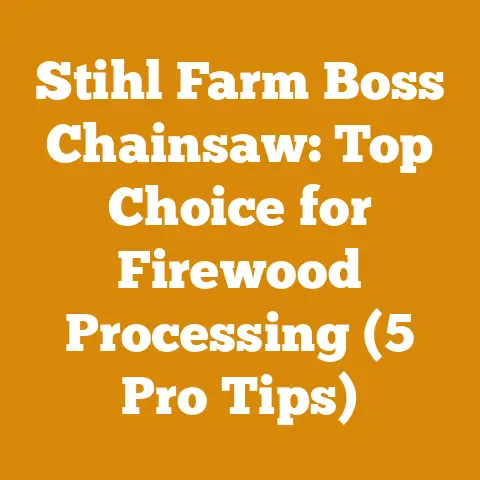Country Hearth 2500 Wood Stove Tips (5 Pro Hacks for Efficiency)
Imagine coming home on a crisp winter evening, the scent of woodsmoke in the air, and settling in front of a roaring fire that radiates warmth throughout your entire home. That’s the lifestyle upgrade a highly efficient wood stove can bring. But to truly unlock its potential, especially when dealing with a workhorse like the Country Hearth 2500, requires more than just loading wood and striking a match. It demands understanding, technique, and a few pro hacks. As someone who’s spent years felling trees, processing timber, and relying on wood heat to warm my own home, I’m here to share my hard-earned wisdom. Let’s dive into how to maximize your Country Hearth 2500’s efficiency and transform your winter heating experience.
Country Hearth 2500 Wood Stove Tips: 5 Pro Hacks for Efficiency
The Country Hearth 2500 is a solid stove, known for its heating capacity and reliability. However, like any wood-burning appliance, its performance hinges on how well you operate it. Over the years, I’ve seen firsthand how small adjustments can lead to significant improvements in heat output, wood consumption, and overall user satisfaction. These hacks aren’t just theories; they’re practical strategies I’ve personally implemented and refined through countless cords of wood.
1. Master the Art of Wood Selection and Seasoning
This is the bedrock of efficient wood stove operation. The type of wood you burn and its moisture content dramatically impact heat output, creosote buildup, and overall stove performance. I’ve seen many people struggle with damp, punky wood, and the results are always the same: a smoky fire, minimal heat, and a chimney coated in dangerous creosote.
Understanding Wood Types: Hardwoods vs. Softwoods
Hardwoods like oak, maple, hickory, and ash are denser than softwoods like pine, fir, and spruce. This density translates to a higher BTU (British Thermal Unit) content per cord, meaning they release more heat when burned.
- Oak: A top choice, offering long burn times and excellent heat. It generally yields around 24 million BTUs per cord.
- Maple: Another excellent option, providing consistent heat and burning cleanly. Expect roughly 20 million BTUs per cord.
- Hickory: Known for its high heat output and distinctive aroma. It can deliver up to 28 million BTUs per cord.
- Ash: Easy to split and burns well, producing around 20 million BTUs per cord.
- Pine: While readily available, pine burns quickly and produces more creosote due to its higher resin content. It’s best used for kindling or shoulder-season fires when less heat is needed. It typically yields around 16 million BTUs per cord.
I primarily burn oak and maple in my Country Hearth 2500. I find that a mix of these two hardwoods provides a good balance of heat output, burn time, and ease of splitting.
The Importance of Seasoning: Achieving Optimal Moisture Content
“Seasoning” refers to the process of drying wood to reduce its moisture content. Freshly cut (“green”) wood can contain over 50% moisture, which significantly reduces its heating value and increases creosote production. Ideally, you want to burn wood with a moisture content below 20%.
-
How to Season Wood:
- Split the wood: Splitting exposes more surface area, accelerating the drying process. I use a hydraulic log splitter for larger rounds, but a good maul and wedge work well for smaller pieces.
- Stack it properly: Stack the wood in a single row, elevated off the ground on pallets or timbers. This allows air to circulate freely. Leave space between rows for even better airflow.
- Provide cover: Cover the top of the stack with a tarp or roofing material to protect it from rain and snow, but leave the sides open for ventilation.
- Allow sufficient time: Seasoning typically takes 6-12 months, depending on the wood type, climate, and stacking method. Hardwoods, due to their density, generally require longer seasoning times than softwoods.
-
Measuring Moisture Content:
- Moisture Meter: A moisture meter is an invaluable tool for determining the moisture content of your firewood. Insert the probes into a freshly split piece of wood to get an accurate reading. I recommend a pin-type meter for the most precise results.
- Visual Inspection: Seasoned wood will be lighter in weight, have cracks in the end grain, and sound hollow when struck against another piece.
- The Soap Test: Apply dish soap to one end of the log. Blow air through the other end. If bubbles form, the wood is likely still too wet.
I’ve found that using a moisture meter is the most reliable way to ensure my wood is properly seasoned. I aim for a moisture content between 15% and 20% for optimal burning.
Takeaway: Prioritize hardwoods and ensure your wood is properly seasoned to a moisture content below 20%. Invest in a moisture meter to accurately assess your firewood’s readiness.
2. Mastering the Country Hearth 2500’s Air Controls
The Country Hearth 2500 features primary and secondary air controls that regulate the amount of oxygen entering the firebox. Understanding how to adjust these controls is crucial for achieving efficient combustion and maximizing heat output.
Primary Air Control: Fueling the Fire
The primary air control regulates the air entering the firebox from below the fuel. Opening the primary air control increases the intensity of the fire, while closing it reduces the burn rate.
- Starting a Fire: Open the primary air control fully to provide ample oxygen for igniting the kindling and establishing a strong fire.
- Maintaining a Fire: Once the fire is established, gradually reduce the primary air control to maintain a steady burn rate. Experiment with different settings to find the optimal balance between heat output and burn time.
- Reloading the Stove: Open the primary air control briefly before reloading the stove to prevent smoke from escaping into the room.
Secondary Air Control: Burning Off Gases
The secondary air control introduces air above the fuel, promoting the combustion of gases and smoke that would otherwise escape up the chimney. This significantly improves efficiency and reduces creosote buildup.
- Engaging Secondary Combustion: Once the fire is burning hot, open the secondary air control to ignite the gases rising from the wood. You should see flames dancing above the fuel, indicating that secondary combustion is occurring.
- Optimizing Efficiency: Adjust the secondary air control to maintain a clean, efficient burn. Too little air will result in smoky flames and creosote buildup, while too much air can cool the firebox and reduce heat output.
My Approach to Air Control Management
I typically start with both the primary and secondary air controls fully open when starting a fire. Once the fire is established, I gradually close the primary air control to about halfway and adjust the secondary air control to achieve a clean, efficient burn. I monitor the flames and smoke coming from the chimney to fine-tune the settings. A clear or faintly shimmering plume indicates optimal combustion. Dark smoke signifies incomplete combustion and the need for more secondary air.
Takeaway: Experiment with your Country Hearth 2500’s air controls to find the optimal settings for different wood types and burning conditions. Observe the flames and smoke to fine-tune your adjustments.
3. The Importance of Proper Loading Techniques
How you load your wood stove significantly impacts its performance. A haphazardly loaded stove can lead to uneven burning, reduced heat output, and increased creosote buildup. I’ve learned over the years that a well-organized firebox is a happy firebox.
The Top-Down Burn Method
This method involves placing larger logs at the bottom of the firebox and progressively smaller pieces on top, finishing with kindling. It promotes a cleaner, more efficient burn by igniting the kindling at the top and allowing the fire to burn downwards.
-
Benefits:
- Reduced smoke and creosote production
- Longer burn times
- More even heat distribution
-
How to Implement:
- Place two or three large logs at the bottom of the firebox, leaving space between them for airflow.
- Arrange smaller pieces of wood on top of the logs, crisscrossing them to create a stable platform.
- Top with kindling and a fire starter.
- Light the kindling and allow the fire to burn downwards.
The Traditional Method (East-West or North-South)
This method involves placing logs horizontally (east-west) or vertically (north-south) in the firebox. It’s a simple and effective way to load the stove, but it’s important to leave space between the logs for airflow.
- East-West Loading: Place logs horizontally, parallel to the front of the stove. This method is best suited for smaller fireboxes.
- North-South Loading: Place logs vertically, perpendicular to the front of the stove. This method is ideal for larger fireboxes and allows for longer burn times.
My Preferred Loading Technique
I typically use a modified version of the top-down burn method. I place two large logs at the bottom of the firebox, leaving a small gap between them. I then arrange smaller pieces of wood on top, crisscrossing them to create a stable platform. Finally, I place a few pieces of kindling and a fire starter on top. This method provides a good balance of heat output, burn time, and ease of loading.
Takeaway: Experiment with different loading techniques to find the one that works best for your Country Hearth 2500 and your burning preferences. Always prioritize airflow and stability when loading the stove.
4. Regular Maintenance: Keeping Your Stove in Top Shape
Regular maintenance is essential for ensuring the safe and efficient operation of your Country Hearth 2500. Neglecting maintenance can lead to reduced heat output, increased creosote buildup, and even dangerous chimney fires. I treat my wood stove like any other important piece of equipment – regular care ensures it performs reliably for years to come.
Chimney Cleaning: Preventing Creosote Buildup
Creosote is a flammable byproduct of incomplete combustion that can accumulate in the chimney. Regular chimney cleaning is crucial for preventing chimney fires.
- Frequency: The National Fire Protection Association (NFPA) recommends that chimneys be inspected at least once a year and cleaned as needed. I clean my chimney twice a year – once in the spring after the heating season and once in the fall before the heating season begins.
- Methods:
- Professional Chimney Sweep: Hiring a professional chimney sweep is the safest and most effective way to clean your chimney. They have the tools and expertise to remove creosote and identify any potential problems.
- DIY Chimney Cleaning: If you’re comfortable cleaning your own chimney, you’ll need a chimney brush that fits your chimney’s diameter, extension rods, and a dust mask. Follow the manufacturer’s instructions carefully.
Inspecting and Maintaining the Stove
Regularly inspect your Country Hearth 2500 for signs of wear and tear.
- Door Gasket: Check the door gasket for cracks or damage. A damaged gasket can allow air to leak into the firebox, reducing efficiency and increasing creosote buildup. Replace the gasket as needed.
- Baffle Boards: Inspect the baffle boards for cracks or warping. Damaged baffle boards can reduce efficiency and increase smoke production. Replace them as needed.
- Air Controls: Ensure the air controls move freely and are not obstructed by debris.
- Ash Removal: Remove ash regularly to prevent it from accumulating and blocking airflow. I typically remove ash every few days, depending on how frequently I use the stove.
My Maintenance Schedule
- Daily: Empty ash, inspect the door gasket visually.
- Weekly: Check air controls, clean the glass.
- Twice Yearly: Chimney cleaning, thorough stove inspection (gaskets, baffle boards).
Takeaway: Establish a regular maintenance schedule for your Country Hearth 2500. Clean your chimney regularly, inspect the stove for signs of wear and tear, and replace worn parts as needed.
5. Fine-Tuning for Optimal Draft
Proper draft is essential for efficient wood stove operation. Draft refers to the flow of air up the chimney, which draws smoke and gases out of the firebox and provides oxygen for combustion. Insufficient draft can lead to smoky fires, creosote buildup, and backdrafting, while excessive draft can cause the fire to burn too quickly and waste fuel. I’ve wrestled with draft issues in different homes, and understanding how to optimize it is key to a trouble-free heating season.
Factors Affecting Draft
- Chimney Height: A taller chimney generally creates a stronger draft.
- Chimney Diameter: The chimney diameter should be appropriately sized for the stove. Too small of a diameter can restrict airflow, while too large of a diameter can cause the flue gases to cool too quickly, leading to creosote buildup.
- Chimney Location: Chimneys located on exterior walls are more susceptible to cold temperatures, which can reduce draft.
- Weather Conditions: Cold, windy weather generally increases draft, while warm, humid weather can decrease it.
- Obstructions: Obstructions in the chimney, such as bird nests or creosote buildup, can restrict airflow and reduce draft.
Troubleshooting Draft Issues
-
Insufficient Draft:
- Ensure the wood is properly seasoned: Wet wood produces more smoke and reduces draft.
- Warm the chimney: Before starting a fire, warm the chimney by burning a small amount of newspaper or kindling at the base of the chimney. This helps to establish a draft.
- Extend the chimney: If the chimney is too short, consider extending it to improve draft.
- Install a chimney liner: A chimney liner can improve draft and protect the chimney from corrosion.
- Check for obstructions: Inspect the chimney for bird nests, creosote buildup, or other obstructions.
-
Excessive Draft:
- Install a barometric damper: A barometric damper automatically regulates the draft by allowing outside air to enter the chimney.
- Close the air controls: Reduce the amount of air entering the firebox by closing the primary and secondary air controls.
- Use a larger diameter stove pipe: A larger diameter stove pipe can reduce draft.
My Draft Management Strategies
I’ve found that maintaining a clean chimney and using properly seasoned wood are the most effective ways to ensure proper draft. I also pay attention to the weather conditions and adjust the air controls accordingly. On cold, windy days, I may need to close the air controls slightly to prevent the fire from burning too quickly. On warm, humid days, I may need to open the air controls more to maintain a good draft.
Takeaway: Understand the factors that affect draft and troubleshoot any draft issues that may arise. Maintain a clean chimney, use properly seasoned wood, and adjust the air controls as needed to optimize draft.
By implementing these five pro hacks, you can unlock the full potential of your Country Hearth 2500 wood stove and enjoy a warm, efficient, and safe heating experience. Remember, wood heating is a craft. It requires attention, practice, and a willingness to learn. But the rewards – the cozy warmth, the satisfaction of self-reliance, and the connection to nature – are well worth the effort. Now, go forth and master the art of wood burning!






